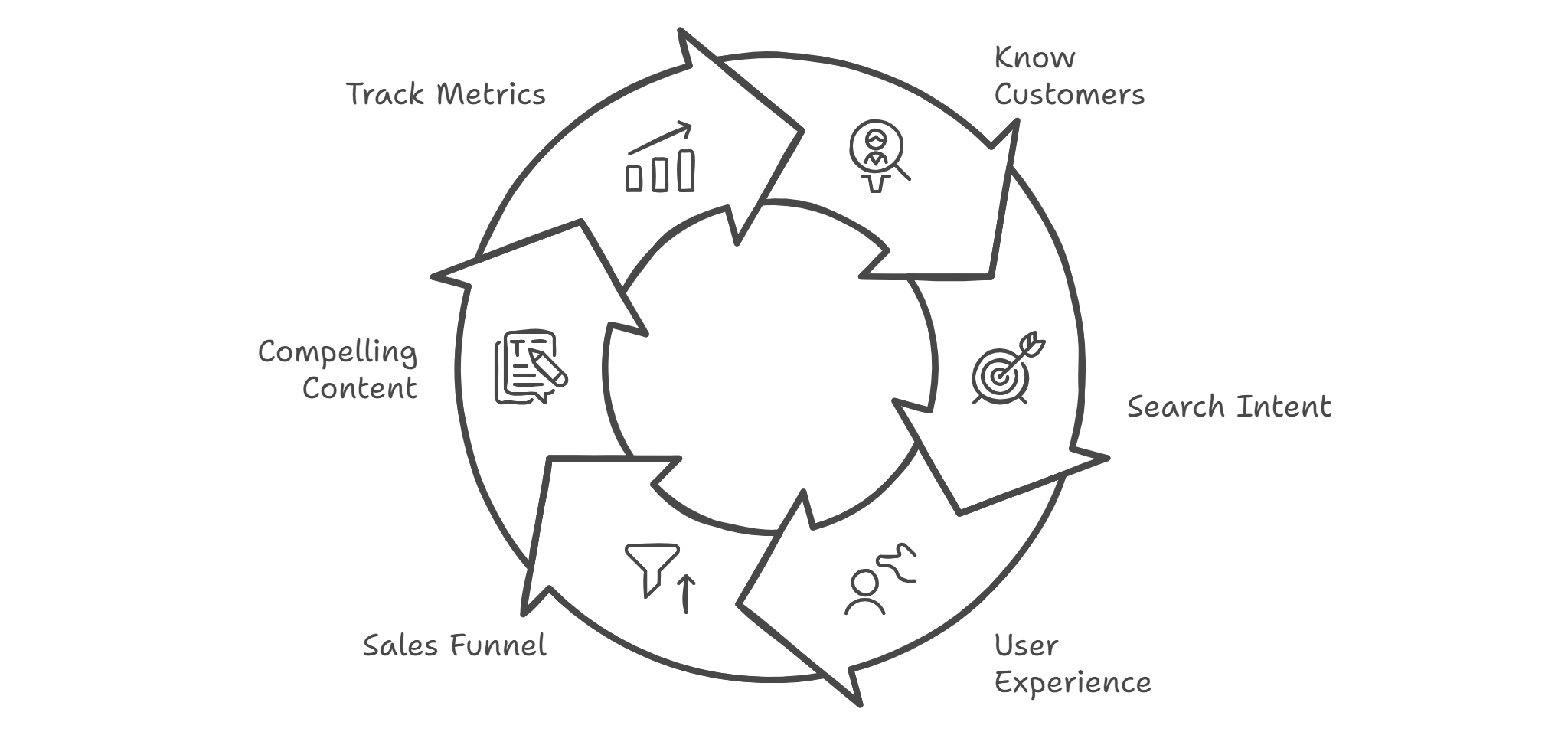Most businesses focus on traffic when they think about SEO. More visitors, more clicks – that must mean success, right? Not necessarily. Traffic alone doesn’t pay the bills. Revenue does.
The real question is: How do you turn SEO traffic into paying customers? That’s what we’re diving into today.
If your SEO strategy isn’t contributing to actual business growth, something is missing. Maybe you’re targeting the wrong keywords, failing to align with your customer’s journey, or tracking vanity metrics instead of revenue drivers.

While driving traffic is essential, it’s equally important to assess whether SEO is a worthwhile investment for your business. For a comprehensive analysis, explore this article on the value of SEO in 2025.
Knowing your customer challenges
Start with business issues, not technical fixes
SEO isn’t just about optimising for Google—it’s about solving real problems for real people. If you don’t understand your customers’ biggest challenges, you’ll never create content that drives conversions.
Many businesses get this wrong. They optimise pages for search volume, not search intent. Ranking #1 for a keyword is useless if it attracts the wrong audience or visitors who never convert.
A great way to ensure your SEO strategy aligns with business goals is by implementing conversion rate optimisation (CRO) techniques. Learn more about CRO and its impact on SEO here.
Here’s what to do instead:
- Talk to your sales team and customer support to understand the most common pain points and objections customers have before making a purchase.
- Check search queries in Google Search Console (GSC) to see what people are actually searching for when they land on your site. Are they looking for information or ready to buy?
- Analyse competitor content and identify gaps in their approach. What questions are they not answering that your audience is asking?
- Read customer reviews on platforms like Trustpilot, G2, and Reddit to uncover frustrations and desires directly from real users.
By gathering these insights, you can create content that doesn’t just attract traffic but turns visitors into customers.
Listening to clients needs
Gather insights that lead to profitable SEO tactics
SEO that drives revenue starts with understanding search intent. Every search falls into one of three categories:
- Informational – People looking for answers, like “How does [product] work?”
- Navigational – Users searching for a specific brand or service, like “Best [product] brands”
- Transactional – Buyers ready to purchase, searching for terms like “Buy [product] online” or “[product] discount code.”
Understanding search intent is key to driving revenue. Many businesses focus too much on generic keyword rankings rather than how people actually search for solutions. Here’s a detailed breakdown of how organic traffic and user behaviour shape SEO success.
Another crucial element? User experience (UX). If your content attracts visitors but doesn’t guide them toward action, conversions suffer. That’s where CRO and SEO-driven UX improvements come into play. See how SEO and UX work together for better results.
Most websites invest heavily in informational content (blog posts, guides) but neglect transactional content – where the money is.
Here’s how to fix that:
- Analyse search queries that lead to conversions: Use GA4 and Google Search Console to track which keywords bring visitors who actually buy.
- Survey past customers: Ask them what information helped them decide to purchase. What pages did they visit before converting?
- Use heatmaps and session recordings: Tools like Hotjar and Clarity show where visitors drop off on landing pages, helping you identify conversion roadblocks.
Too many businesses chase traffic without understanding what drives purchases. The goal isn’t just ranking – it is ranking for searches that bring in paying customers.
Mapping your SEO to the sales funnel
Align SEO strategies with each step of the customer journey
Most SEO strategies fail because they don’t match how people actually buy. Visitors don’t go from first-time searchers to customers instantly – they follow a journey. If your content isn’t mapped to that journey, you’re leaving money on the table.
A structured SEO sales funnel ensures that you’re targeting potential customers at the right stage of their journey. See how businesses can align their SEO with user intent for maximum conversions.
How to structure your SEO strategy:
- Top of the funnel (Awareness) – Blog posts, industry trends, and guides to educate new users.
- Middle of the funnel (Consideration) – Product comparisons, case studies, and solution-driven content.
- Bottom of the funnel (Conversion) – Sales pages, landing pages, pricing breakdowns, and customer testimonials.
Example: Let’s say you sell accounting software.
- A blog post on “How to automate bookkeeping” (awareness)
- A comparison of “QuickBooks vs Xero” (consideration)
- A pricing page targeting “Best small business accounting software” (conversion)
Another mistake businesses make? Not optimising category and product/service pages. If you have an e-commerce store or a service-based business, ensure these pages target transactional intent keywords like “Best CRM for startups” or “Plumber near me emergency service.”
When SEO is mapped to the sales funnel, it’s no longer just about getting traffic – it’s about getting the right traffic at the right time.

Measuring what matters
Simple metrics that tie SEO directly to revenue growth
Most businesses track SEO the wrong way. They focus on rankings, impressions, and traffic – but these don’t pay the bills. They get lost in vanity metrics when SEO success should be measured by revenue-driven data. Understanding the right metrics is crucial. Find out which SEO metrics truly matter for business growth.
If you want SEO to drive revenue, track metrics that actually matter:
- Conversion rate – What percentage of visitors take action (buy, sign up, request a demo)?
- Lead quality – Are organic leads converting into customers or just browsing?
- Revenue per organic session – How much money does each SEO visitor bring in?
- Customer lifetime value (CLV) – What’s the long-term value of an SEO-driven customer?
- Keyword performance linked to revenue – Instead of tracking keyword rankings alone, track which ones drive actual sales.
How to track these metrics:
- Google Analytics 4 (GA4) – Set up conversion tracking to measure purchases and lead generation.
- CRM integration – Connect SEO data with tools like HubSpot or Salesforce to track customer journeys.
- Heatmaps & session recordings – Understand how users interact with key pages and where they drop off.
When you measure SEO by revenue, not rankings, you’ll stop chasing vanity metrics and start making smarter business decisions.

Conclusion: Turn SEO into a revenue-generating machine
SEO should drive sales, not just clicks. If your strategy isn’t leading to revenue, something’s wrong.
- Focus on solving real customer problems, not just optimising for search engines.
- Align SEO with the sales funnel so that you’re targeting potential buyers at the right stage.
- Track metrics that matter to ensure your efforts are tied to actual business growth.
SEO isn’t just about ranking #1. It’s about making sure that ranking leads to revenue. If you’re not seeing results, now’s the time to fix it.
Ready to optimise your SEO for revenue? Start by auditing your content strategy and making sure you’re targeting the right people at the right stage of their journey.